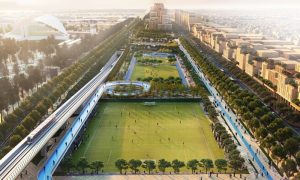The illuminating future of lighting design
Light years ahead: Forget the simple bulb – lighting technology can now influence human behaviour and even connect us to the web

Like most devices around us, the once simple light bulb has evolved into a more complex gadget. From being used to illuminate a room, lighting technology has become more multi-functional, and is now capable of speeding up the healing process, influencing our behaviour and even promoting connectivity to the internet, among other abilities.
But what exactly has led to lighting technology improving at such a rapid pace? Experts across the board believe that advancements in LED technology over the last couple of years are among the main reasons for this growth.
Mark Vowles, director at Nulty, points out that the industry is now dealing with electronic systems rather than the traditional filament lighting, which opens up endless possibilities to develop smart systems. In fact, with the micronisation of electronics and LEDs, a number of elements can be encapsulated in LED products.
“You can have cameras, heat sensors, earthquake sensors, smoke detectors and speakers – the list is really endless, but it comes with a price tag. In principle, the clients in the Middle East like the concept of a smart system, but most of the time the initial capital expenditure outweighs the long-term repayments of the system, so it gets value engineered out.
“In fact, a company called Enlighted Inc has made some really interesting developments in smart systems. One such development is incorporating sensors within lighting that track the movement of individuals around a retail space, which gives critical feedback to retailers on how people move about the store, points of sale (POS) that are doing well and how long people spend shopping.”

Giving another practical example, Veit Müller, senior vice president MEIA at the Zumtobel Group, says today’s technology can ensure more user-focused and user-friendly operation of luminaires. For example, at Zumtobel’s office, every desk cluster is able to control its lighting individually. Employees can dim their cluster’s lights up or down by simply using their smartphones or computer desktops, and in some clusters they can even choose the colour temperature they prefer.
“The current setting in a cluster imitates the natural rhythm of daylight. The day starts with a very warm 2,700 Kelvin in the early morning, simulating the sunrise. From 7AM towards lunchtime, the colour temperature gradually adjusts to 4,000-5,000 Kelvin, synchronising people’s circadian rhythm and suppressing the melatonin release. And towards the end of the day, the lighting turns warmer again, allowing the release of melatonin and preparing the body for the rest phase.
“This is possible through intelligent lighting controls and sensors, which are furthermore crucial to maximise energy savings. Looking at the specs and designs of future projects, the Middle East is making progress on including intelligent sensors and controls, and we can finally see a larger shift towards using LED technology.”
Sergio Padula, technical director at iGuzzini, adds that it’s not just lighting that’s been getting more efficient but its fittings as well. In fact, fittings are now able to adapt to the harshest temperatures and conditions, as LED is a controllable and manageable component. It allows the fitting to adapt to the surrounding environment and guarantees high performance.
“Lighting fittings react very well to different conditions and can tolerate adjustments in intensity, dimming without compromising the light quality. LEDs emit coloured light depending on the doping applied to its chip, without using external filters required by traditional sources. This improves the system’s efficiency, and the absence of ultraviolet and infrared light makes LEDs ideal for food and exhibition applications, where these radiations could be damaging.
“Now this new technology is extremely popular in the region. It’s interesting to note that in 2015, 70% of our company’s turnover was from LED fittings, but when our Middle East branch launched in 2008, LED represented only 20% of the overall turnover!”
Given this growth, Padula says the company has even increased the range of LED products in its portfolio, from 15% in 2008 to 80% in 2014.
Obviously, reducing energy costs is one of the most attractive benefits. In fact, experts suggest that with LEDs, it’s possible to save up to 70-80% of energy consumption.
Müller says it’s all about activity-based lighting, which means having light where it is actually required. Things like daylight sensors measure the actual daylight inside the room and then adjust the artificial light accordingly, to ensure excellent visibility.
“Additionally, these kind of multi-sensors are not only designed for detecting light but are also capable of detecting the presence of movement of people or even vehicles. As compared to conventional PIR (passive infrared sensor) and radar sensors, a contrast sensor system features intelligent detection of objects and operates with significantly higher precision, making it faster and considerably less prone to errors.
“These sensors can accurately monitor any walking or driving motion with ceiling heights up to 20 metres, making it ideal for application-specific solutions in which high energy efficiency is of major importance.”
Lighting technology such as cloud-based lighting can help with maintenance as well. Shaw points out that remote centralised control systems open up an array of opportunities for facility management.
“For example, a typical hotel has thousands of light points. A two-way control system can tell the maintenance team if a downlight in a guest room toilet has failed, without the need to perform regular inspections. Furthermore, it can predict the life span of a fixture, which can facilitate both improved inventory management of spare parts, as well as scheduling more effective re-lamping for conventional light sources.
“Most importantly, it can gather information on a user’s behaviour. For example, a corridor that dims down after 10 minutes of inactivity could eventually be adjusted to five depending on the usage pattern, and at the end of the year, those five minutes represent hours of energy saving.”
Müller expands further. For example, if a single presence sensor is integrated into a luminaire, it can detect whether an office is occupied or not. This information can be sent to the cloud and stored on a server. The data can then be evaluated and sent not only to lighting control systems but also to HVAC systems and security management systems.

Technology like Li-Fi, a communication technology that uses visible light instead of radio frequency like Wi-Fi, is also slowly making its way into the Middle East market.
Alex Shaw, design director for UMAYA, notes that the main advantage of incorporating technology like this is that it is virtually limitless, since the visual light spectrum is much larger than radio frequency. He says it will also be much cheaper, since most of its components already exist in a building’s light fittings. Additionally, it doesn’t generate any electromagnetic interference, making it ideal for hospitals and aircraft too. However, as a relatively new technology, it has a number of downsides at the moment, including short signal range and system reliability.
Vowels believes the introduction of Li-Fi will not have a big impact on lighting design.
“Primarily, lighting design is to design and improve the environment for the occupants, not enhance their access to the internet. I can see the benefits in an open plan office, but when you start configuring partitions and walls in a space, Li-Fi can’t pass through and it becomes redundant. I’ve also read that Li-Fi is affected by bright daylight, which as a designer, we try to encourage the use of as much as possible, as it’s a free, renewable source!”
In terms of challenges, the lighting experts believe that the biggest roadblock in the Middle East is the lack of understanding of the advantages of quality lighting.
Müller says this is mainly due to the lack of education among end users and a lack of awareness from the authorities. “Lighting is the last piece considered on a project, and that’s normally when budgets have already been overshot and value engineering is carried out. The initial investment cost of quality lighting versus the return of investment due to energy savings has historically not been a very strong argument, because of the low energy prices in the region.”
Despite the odds, lighting designers and manufacturers remain excited about the quick progress technology is making.
Padula reiterates his belief that lighting fittings will become ultra-compact, more efficient and integrate further with architectural structures and the environment. Both Shaw and Müller maintain that the development seen in the IoT and Li-Fi will revolutionise the industry, impacting both indoor and outdoor environments.
“For instance, presence sensors in car parks or street lights could indicate where free parking spaces are available, and pass this information on to a SatNav system. Indoor navigation could also be possible by using ‘beacons’ that act as small Bluetooth transmitters in luminaires. With the aid of these transmitters, anyone with an appropriate smartphone app will be able to pinpoint their location to within a few metres, which is ideal for finding your way around a shopping centre, hospital or airport.”
It’s safe to say that the industry is very excited about the technology we’re seeing today. What was once thought to be light years away is now at our doorstep.
“Nobody can really fathom how far we’ve come over the last 10 years, and therefore it would be hard to judge what the next 10 years hold. Rest assured, we will continue to support and encourage lighting manufacturers to invest in research and development and to continue pushing the boundaries,” Vowels concludes.

























